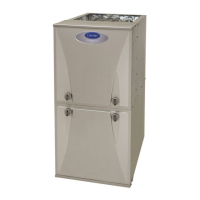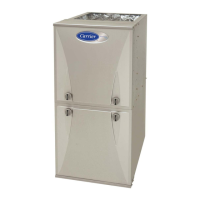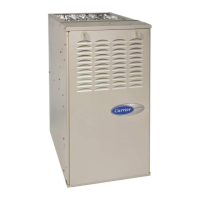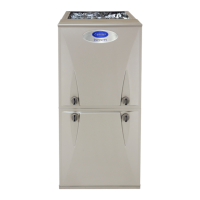PG96MSA: Installation, Start-up, Operating and Service and Maintenance Instructions
Manufacturer reserves the right to change, at any time, specifications and designs without notice and without obligations.
13
A14532
Fig. 13 – Example of Field Drain Attachment (Not Allowed)
CONDENSATE DRAIN CONNECTION
DO NOT trap the drain line in any other location than at the condensate
drain trap supplied with the furnace. If possible, DO NOT route the drain
line where it may freeze. The drain line must terminate at an inside drain
to prevent freezing of the condensate and possible property damage.
Special precautions MUST be made if installing furnace in an area
which may drop below 32° F (0° C). This can cause improper operation
or damage to the equipment. If the furnace environment has the potential
of freezing, the drain trap and drain line must be protected. In areas
where the temperature may be below 32° F (0° C), a Condensate Freeze
Protection kit is required. The kit includes a condensate trap with heat
pad and replaces the factory-installed condensate trap. Refer to the
Accessory section of the Product Data for current kit number. A
self-regulating, shielded and waterproof heat tape rated at 3 to 6 watt per
foot (10 to 20 watt per meter) at 115 volt, 40°F (4°C) may be used to
provide freeze protection of the remaining condensate drain line. Wrap
the drain trap and drain line with the heat tape and secure with
appropriate plastic ties. Follow the heat tape manufacturer’s
recommendations. Prime the trap before furnace operation.
The condensate drain line must be supported and/or secured per local
codes. Supports and clamps should be spaced to prevent the drain line
from sagging or being dislocated from the furnace or termination point.
In the absence of local codes, consult the current edition of the National
Standard Plumbing Code, in the U.S. or the National Plumbing Code of
Canada in Canada.
Upflow/Downflow Orientation
In the Upflow or Downflow orientation, the condensate trap is inside the
furnace casing. The condensate drain must be routed from the trap
through the furnace casing. The condensate drain can be routed through
the left or right side of the casing. (The left or right side is as you are
viewing/facing the furnace from the front.)
An indoor coil condensate drain or humidifier drain can be connected to
the external furnace condensate drain provided:
• The drains are not hard piped together, and
• There is an air gap at the point where the two drain lines meet or
• All condensate piping is at least 3/4-in. PVC and there is a relief tee at
the top of condensate drain piping as shown in Fig. 12.
NOTE: On narrower casings, it may be easier to remove the condensate
trap, connect the drain line components and re-install the condensate
trap. Read the steps thoroughly to familiarize yourself with the required
steps.
For Right Side Condensate Drain:
1. Remove the 7/8-in. knockout or plug from the right side of the
casing. See Fig. 15 for suggested knockout or plug removal
technique.
2. Remove the pre-formed rubber drain elbow and two spring clamps
from the loose parts bag.
3. Slide a spring clamp 1-inch (25 mm) down the plain end (the end
without the formed grommet) of the drain elbow.
NOTICE
!
The field-supplied, accessory horizontal drain trap grommet is ONLY
REQUIRED FOR DIRECT VENT APPLICATIONS. It it NOT
required for applications using single-pipe or ventilated combustion air
venting.
NOTICE
!
The condensate trap extends below the side of the casing in the
horizontal position. A minimum of 2-in. (51 mm) of clearance is
required between the casing side and the furnace platform for the trap to
extend out of the casing in the horizontal position. Allow at least 1/4-in.
per foot (20 mm per meter) of slope down.
CAUTION
!
FROZEN AND BURST WATER PIPE HAZARD
Failure to protect against the risk of freezing may result in property
damage.
Special precautions MUST be made if installing furnace in an area
which may drop below freezing. This can cause improper operation or
damage to equipment. If furnace environment has the potential of
freezing, the drain trap and drain line must be protected. The use of
accessory drain trap heaters, electric heat tape and/or RV antifreeze is
required for these installations.
+
+
+
Condensing
Furnace
-
-
-
-
-
Evaporator Coil
+
+
+
< +
< +
< +
+
Blower
-
+ = Positive pressure
< + = Pressure lower than areas with +
ï = Negative pressure
Blower creates positive pressure.
Positive pressure extends into coil
condensate drain (no trap).
Furnace condensate does not flow
consistently when drain is at positive
pressure.
+
DIRECTION
OF
AIRFLOW
+
+
+
+
+
+
+
+
+
+
Condensing
Furnace
-
-
-
-
-
Evaporator Coil
+
+
+
< +
< +
< +
+
Blower
-
3/4”
PVC
1/2
3/4
1/2”
CPVC
or
larger*
+ = Positive pressure
< + = Pressure lower than areas with +
ï = Negative pressure
+
3/4”
PVC
DIRECTION
OF
AIRFLOW
+
+
+
+
1/2
3/4
3/4
3/4
Open
standpipe
+
+
3/4
+
+
+
+
Condensing
Furnace
-
-
-
-
-
Evaporator Coil
+
+
+
< +
< +
< +
+
Blower
-
3/4”
PVC
3/4
1/2”
CPVC
or
larger*
+ = Positive pressure
< + = Pressure lower than areas with +
ï = Negative pressure
+
3/4”
PVC
DIRECTION
OF
AIRFLOW
+
+
+
+
3/4
3/4
3/4
3/4
3/4
+
+
+
+
+
+
+
++
+
CAUTION
!
PROPERTY DAMAGE HAZARD
Failure to follow this caution ma result in burst water pipes and/or
property damage.
If a condensate pump is installed, a plugged condensate drain or a failed
pump may cause the furnace to shut down. Do not leave the home
unattended during freezing weather without turning off water supply
and draining water pipes or otherwise protecting against the risk of
frozen pipes

